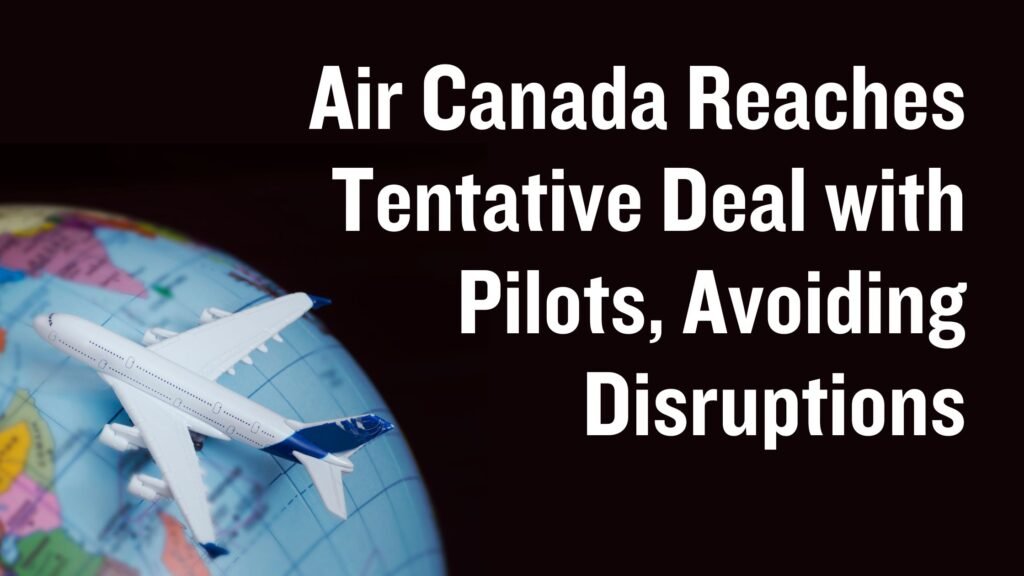One of the largest airlines in North America, Air Canada, has reached a significant agreement with its pilot. This development demonstrates an essential step in preventing likely changes to the services this airline offers. These changes could have had detrimental effects on passengers as well as the aviation sector. The proposed deal creates a new basis for the company’s expansion while simultaneously acknowledging the achievements of Air Canada and Air Canada Rouge pilots. The terms will stay under wraps until the union members ratify them and the airline’s board of directors approves them, which should happen within the next month, the firm reports.
Behind the Scenes: How the Agreement Came Together
Air Canada pilots are set to receive over 42% raises over the course of a four-year tentative deal. The accord must be accepted by the union’s 5,200 Air Canada pilots in a vote during the next month. According to the agreement reviewed by The Globe and Mail, the pilots would receive a 26 percent boost retroactive to September 2023, followed by four percent raises in 2024, 2025, and 2026.
In the second year of the agreement, which begins on September 30, 2024, a Boeing 737 captain, the highest-ranking staff member, would be paid $280 to $312 per hour, based on the period of time they have been in that position. The initial officer on the same airplane would begin at $87 per hour and increase to $207 if they have 12 years of seniority. The new deal would begin hourly compensation for a relief pilot, the most junior, on a wide-body jet at $87. Captains’ hourly pay on wide-body planes would vary from $317 to $424, contingent upon the aircraft model.
Key Takeaways from the Deal
- The agreement initiates an increase in the salary of the pilots, addressing the concerns regarding wage stagnation, as inflation rises significantly in the past few years.
- One of the major issues faced by the pilot is the extenuating working hours, and the growing demand for work-life balance. The new agreement will ensure flexibility and decrease extended flight hours.
- In the post Covid-19 pandemic era, the aviation industry is still recovering from loss. The agreement made establishes job security and includes provisions to protect pilot jobs, in lieu of future industry slump or restructuring methods.
Why This Deal Matters for Air Canada
1. Averting Service Disruptions
Without this initial agreement, Air Canada faced worker strikes or slowdowns, which may have had an adverse impact on North America’s aviation industry. With almost 4,500 pilots employed by the airline, service disruptions might have resulted to:
- Thousands of people are left stranded due to flight cancellations.
- Air Canada may have experienced considerable revenue losses during the busy travel season.
- Service problems may have damaged customer trust, prompting passengers to seek alternatives.
2. Economic Impact on the Aviation Industry
After two years of challenges caused by the pandemic, the aviation industry in Canada and throughout the world made a substantial recovery in 2024. The International Air Transport Association (IATA) projects that by 2024, there would be up to 4.35 billion passengers globally, almost exactly the same as there were before the epidemic. To fully benefit from this resurgence, Air Canada must continue to provide its services. Related industries include travel and hospitality as well as airport services would have been impacted by a strike.
What This Means for Passengers and Pilots
For passengers
This agreement benefits the passengers the most, especially during the busiest times of the year i.e., the holiday seasons. They’ll not have to worry about flight cancellations. The passengers will have consistent Air Canada’s domestic and international routes. There is less chance of hikes in ticket prices.
For Pilots
Pilots experience several benefits from this agreement. They now have better work-life balance, and also job security in case of recession.
A New Era for Labor Relations in Aviation?
This accord is more than simply a victory for Air Canada’s pilots; it might set the tone for other carriers in similar discussions. Several North American carriers, notably Delta and WestJet, are now in discussions with their pilots. With over 600,000 more pilots anticipated to be needed globally by 2040 to satisfy rising demand, unions are well-positioned to negotiate higher terms.
What’s Next for Air Canada?
The tentative deal is a welcome development, but it is not yet complete. The proposal will be put to a vote by union members in coming weeks. If approved, it will end months of uncertainty and provide Air Canada pilots with a new contract.
The next steps for Air Canada will be to continue to develop its operations in order to benefit from the industry’s revival. Preventing a pilot strike aids the airline in keeping up its competitiveness in both the North American and Canadian markets.
Conclusion
The tentative deal agreed between Air Canada and its pilots benefits both parties by allowing the airline to avoid costly service disruptions while resolving significant worker problems. As travel demand continues to rise, maintaining labor peace will be critical to the airline’s future success.
With this agreement, Air Canada is well-positioned to face the challenges ahead, providing dependable service for customers and a stable work environment for pilots. The conclusion of this agreement will be widely watched by the aviation sector, as it might set the tone for future labor discussions across North America.






Leave a Reply